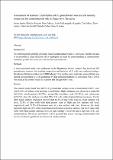| dc.description.abstract | Background
Two billion people globally are using faecal-contaminated water. E. coli poses a health risk due to its potential to cause diseases which highlights the need for understanding its antimicrobial resistance profile and associated factors for contamination.
Methods
A cross-sectional study was conducted in the Bagamoyo district council that involved 163 groundwater sources with sanitary inspection and isolation of E. coli was conducted using a Membrane filtration method and CHROMagar CCA. In this study, antibiotic susceptibility was carried out according to CLSI guidelines by disk diffusion methods. E. coli strain ATCC 25922 was used as the control strain in isolation and susceptibility tests.
Results
The current study found that 44.8% of groundwater samples were contaminated with E. coli, with 83.6% of isolates were resistant to antibiotics. High resistance was observed to cefazolin (56.16%), nitrofurantoin (54.79%), amoxicillin-clavulanic acid (45.21%), and ceftriaxone (42.47%). Also, the study reveals that 70% of E. coli isolates had multidrug resistance. On the other hand, sanitary inspection showed that 46.2% of dug wells were at a high sanitary risk level, 32.8% of tube wells with hand pumps were at High and low sanitary risk level, respectively and 73.3% of boreholes were at a low sanitary risk level. However, the study showed a high rate of E. coli contamination in boreholes at a low sanitary risk level. Also, tube wells with hand pumps and dug wells at high sanitary risk levels had a high rate of E. coli contamination. Moreover, resistant E. coli in groundwater across varying contamination risk levels revealed a significant prevalence of contamination. | en_US |

